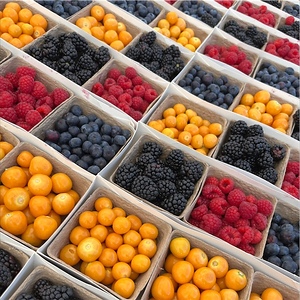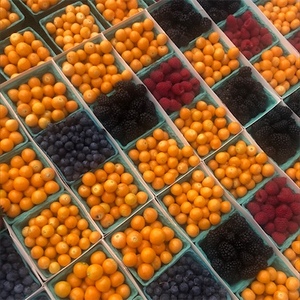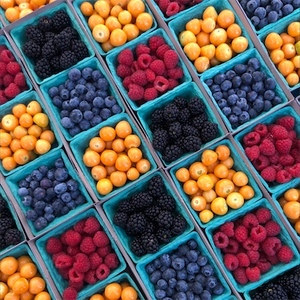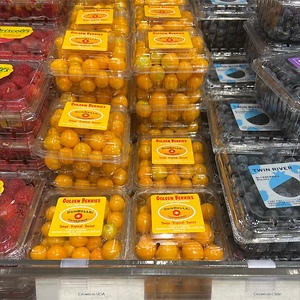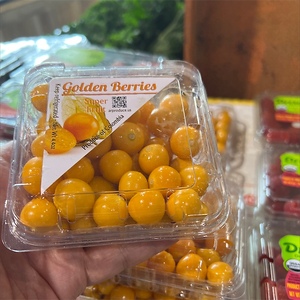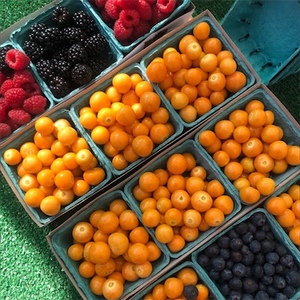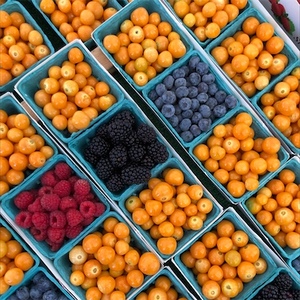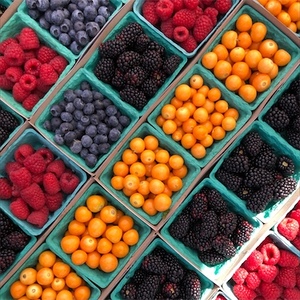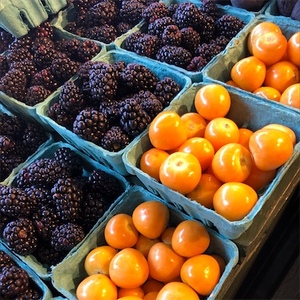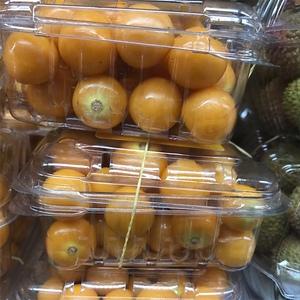


Barbados Gooseberries
Estimated Inventory, bskt : 0
Description/Taste
Barbados gooseberries are small fruits that measure about 1 to 2 centimeters in diameter. They have a round or oval shape resembling that of a cherry tomato. These fruits' skin starts off bright green and transitions to a vibrant orange hue. This skin is shiny with a smooth yet firm texture. Barbados gooseberry flesh has the same orange color as their skin. This flesh is soft, succulent, and opaque. Its hollow center contains inedible seeds that measure about 4 to 5 millimeters wide. The seeds have a circular crater-like shape and a brown or black hue. Barbados gooseberries are highly acidic with a tart, sweet, and overall mellow taste that’s similar to plums and Acerola cherries.
Seasons/Availability
Barbados gooseberries are generally available from late spring to early summer and again in late fall. Their peak season occurs in August and September in Brazil. They are available year-round on the northern coast of Honduras.
Current Facts
Barbados gooseberries are botanically classified as Pereskia aculeate and belong to the Cactaceae family. The Pereksia genus is named after the 16th-century French botanist Nicholas Claude Fabre de Peiresc and consists of other plant varieties from South America including Pereskia diaz-romeroana, Pereskia horrida, and Pereskia weberiana. Barbados gooseberries are commonly referred to as Lemon Vine, Sweet Mary, Blade apples, West Indian gooseberries, Barbados shrubs, and Ora pro nobis in Brazil. They grow on leafy climbing shrubs with vine-like branches that can reach up to 10 meters in length and climb over walls, rocks, and trees. Barbados gooseberry shrubs bloom fragrant ornamental flowers in shades of white, yellow, and pink. The flowers have a distinctive lemon-like aroma that can range from pleasantly sweet to sharply repulsive. These plants are also valued for their sweet and sour gooseberries that may be used in a variety of culinary applications.
Nutritional Value
The leaves and fruits of Barbados gooseberry plants are edible and have a variety of nutritional benefits. They both contain protein and iron to encourage tissue growth and repair, hormone production, oxygen transportation, energy levels, and immune, muscle, and cognitive function. Iron is particularly important during pregnancy because it supports fetal growth and reduces anemia risk. These leaves and fruits provide the body with vitamin C and fiber that help promote collagen production, iron absorption, blood pressure and cholesterol reduction, digestion, weight management, and protection against free radical damage. Barbados gooseberry fruits are also a source of vitamin B that aids in nerve function, metabolism, wound healing, mood regulation, and hair, skin, nail, and eye health. They have been used historically to help treat digestive disorders, muscle damage, insomnia, inflammation, and multiple sclerosis.
Applications
Barbados gooseberries can be consumed raw, cooked, or preserved. They are frequently enjoyed in sweetened syrups, jams, and chutneys where the fruits are stewed and preserved with sugar. Barbados gooseberry compote is often served alongside chicken and pork dishes. These fruits may be turned into sorbets, sauces, juices, ketchup, smoothies, mousses, liqueurs, and salad dressings. They can be tossed fresh into green salads, fruit bowls, yogurt parfaits, oatmeal, cereal, and acai bowls. Barbados gooseberry leaves may be added to salads, soups, and omelets. A flour formed from these leaves can serve as a healthy replacement for white flour that’s made into breads, cakes, pies, and pasta. Barbados gooseberries pair well with strawberries, apples, lemons, limes, oranges, elderflower, chamomile, vanilla, mascarpone, custard, meringue, crackers, brie and camembert cheese, vodka, gin, sauvignon blanc, coconut, grilled mackerel, salmon, parsley, chile peppers, and fish sauce. These fruits should be covered and stored in the refrigerator where they will last for about two weeks.
Ethnic/Cultural Info
In Brazil, Barbados gooseberries are known as Ora pro nobis which means pray for us in Latin. This name originates from the tradition of planting Barbados gooseberries around Catholic churches in the Brazilian state of Minas Gerais. The leaves from these plants had many antioxidants and healing properties but were forbidden from the West African slaves that were brought to this state during colonial times. When priests said the phrase Ora pro nobis during Catholic mass, it was followed by a long prayer where everyone bowed their heads. During this time, the slaves who were required to attend would sneak outside to harvest the forbidden Bardados gooseberry leaves. These plants are still popular in Minas Gerais, particularly in the historic colonial city of Diamantina where the majority of the population uses them regularly. Barbados gooseberry plants are referred to as vegetable meat because they have a high protein content that can serve as an alternative to animal proteins. They are celebrated each May at the Festival do Ora-pro-Nóbis de Sabará where the gooseberry leaves are featured in numerous traditional Brazilian foods. One of the most popular dishes is made with chicken thighs fried in oil with garlic, onions, and lime juice. They are then simmered in stock with salt and pepper. The gooseberry leaves are sautéed separately and added along with scallions, creating a succulent chicken dish commonly served with refried beans called tutu de feijão.
Geography/History
Barbados gooseberries are native to the Caribbean and to the tropical regions of South America that span from Venezuela to Paraguay. They grow in tropical, subtropical, and warm temperate climates with humidity, high rainfall, and temperatures ranging from 20 to 37 degrees Celcius. Barbados gooseberries are primarily found in the wild where they grow in low elevations within forests, thickets, woodlands, riverbanks, savannahs, roadsides, and disturbed and rocky areas. They are also grown in gardens, used as a houseplant, or produced on a small scale commercially. Barbados gooseberries have been consumed for centuries by the indigenous peoples of their native regions. The seeds and fruits began to spread to new areas thanks to Capuchin and brown howler monkeys. The first recorded observation of Barbados gooseberries was made by Charles Plumier, a Royal Botanist for King Louis XIV, during his work in the Caribbean in the late 17th and early 18th centuries. Outside of their native regions, Barbados gooseberries can now be found in Florida, Hawaii, California, Mexico, South Africa, Australia, and China. In some of these places they are considered a weed that has displaced native species. When in season, fresh Barbados gooseberries are foraged from wild plants and commercially cultivated on a small scale worldwide. The harvested fruits are sold in local markets within their growing regions and are also sent to select specialty stores in metropolitan areas.
Recipe Ideas
Recipes that include Barbados Gooseberries. One



